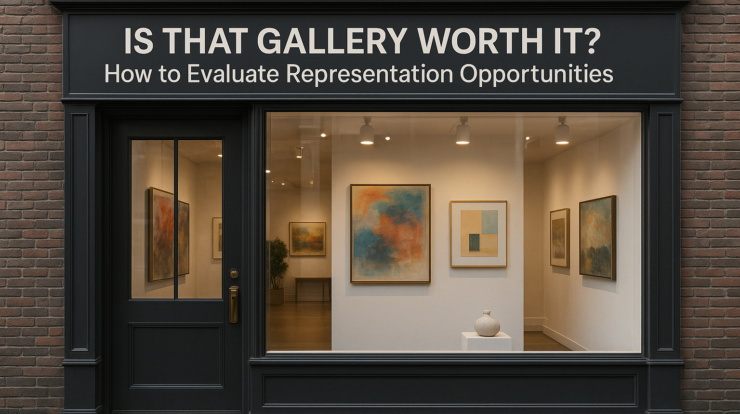
It’s an exciting moment when a gallery expresses interest in your work—or when you spot a potential opportunity and consider reaching out. But not all gallery relationships are created equal. Before you load up the car and drive your artwork across the state, it’s worth asking a few important questions to determine if the gallery is truly a good fit.
Too often, artists jump into gallery partnerships without fully vetting the space or the people behind it. Later, they find themselves frustrated by underwhelming sales, poor communication, or wasted time and resources. The good news? A little due diligence can go a long way.
Here’s how to evaluate whether a gallery opportunity is worth pursuing.
Start With a Clear-Eyed Look at the Gallery
Before you commit, visit the space in person if at all possible. Take in everything: the location, the lighting, the quality of the presentation, the staff interaction, and the mix of artists represented. Ask yourself:
-
Does this gallery feel professional?
-
Is the work well-curated and thoughtfully displayed?
-
Would I be proud to have my work shown here?
One artist I corresponded with recently shared that after a long round trip to deliver artwork, he arrived at a tiny, arts-and-crafts-style gallery that didn’t match the professional image he expected. The experience reminded him—and us—that you shouldn’t assume a gallery is a good fit based solely on a name or online listing. Reality often tells a different story.
Review Their Online Presence
A gallery’s website and social media are often a window into how seriously they take their business. A few things to check:
-
Is the website current and easy to navigate?
-
Are they actively promoting their artists?
-
Can visitors purchase or inquire about work online?
-
Do they have an email list or events calendar?
A weak or outdated online presence doesn’t necessarily disqualify a gallery, but it does suggest they may not be putting significant effort into marketing or collector engagement.
Ask About Their Collector Base
One of the primary benefits of gallery representation is access to a wider collector audience. That’s why it’s important to ask:
-
Who shops here?
-
How do collectors typically find the gallery?
-
What price range do they sell most consistently?
You don’t need precise numbers, but a gallery should be able to give you a general sense of their client base and how they reach them. If they’re vague, hesitant, or overpromising without backing it up, proceed with caution.
Talk to Other Artists They Represent
If you can, discreetly reach out to a few artists currently in the gallery’s stable. Ask about their experience:
-
Do they get regular updates?
-
Have they seen sales or meaningful exposure?
-
Is the relationship professional and respectful?
Most artists will be candid—and their feedback can help you avoid costly missteps.
Consider the Cost of the Opportunity
Gallery representation nearly always requires investment—whether it’s in the form of travel, framing, promotional materials, or just the time spent preparing and delivering your work.
If you’re looking at a gallery with low traffic, limited marketing, and a questionable sales history, it may not be worth the effort, even if there’s no fee involved.
Remember: just because a gallery is willing to show your work doesn’t mean it’s the right place to show it.
When In Doubt, Turn It Into a Learning Experience
If you do decide to proceed with a gallery that turns out to be a poor fit, try not to see it as a failure. Use the opportunity to practice your presentation, gather feedback, or simply observe how visitors respond to your work in a new environment.
Sometimes, these “misses” still open doors to new relationships or help clarify what you’re really looking for in a gallery partner.
Final Thoughts
Evaluating a gallery opportunity comes down to doing your homework and trusting your instincts. Take the time to ask questions, gather context, and imagine what the relationship would look like six months down the road.
Not every opportunity is the right opportunity—but the right ones are worth waiting for.
This is a terrific answer to a very real problem for many artists. Gallery representation is truly important for an artist if they wish to have a large career arc. Why? Because most serious collectors find it a convenient way to shop and also value the opinions a gallery provides and the fact that they assume the gallery is a form of winnowing from the huge number of available artists. However, today, there are also a huge number of galleries – and they go out of business frequently. I would strongly recommend that you try only to deal with galleries that have been in business for a minimum on 3 years, and that you make certain that your are “fits” the gallery in terms of imagery and price. Many galleries have a wide diversity of image, but many are quite specific. Whatever they do, you want your art to have a good “place”. And galleries are focused, for good or ill, on selling. So be sure that prices are set between you and the gallery at amount that will sell – and that your webpage either eliminates prices or has prices that are identical. No matter where your art is, the price s/b the same. I am an artist and writer, have had galleries for almost 50 years, and make my living solely from art. So I write from both sides of the issue.